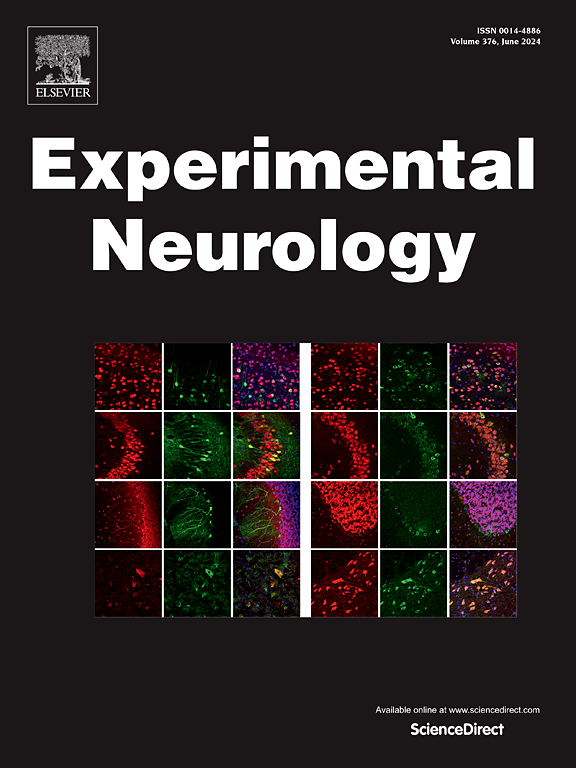SARS-CoV-2 穗状 S1 蛋白诱导小鼠神经胶质细胞 NLRP3 依赖性神经炎症和认知障碍。
IF 4.2
2区 医学
Q1 NEUROSCIENCES
引用次数: 0
摘要
在冠状病毒病 2019(COVID-19)的急性期和后遗症中经常会发现认知障碍,其潜在机制仍不清楚。严重急性呼吸系统综合征冠状病毒2(SARS-CoV-2)的S1蛋白可能是导致与COVID-19相关的认知障碍的原因之一。核苷酸结合域、富含亮氨酸家族、含吡啶结构域-3(NLRP3)炎性体和神经炎症在阿尔茨海默病(AD)认知障碍中发挥着重要作用。然而,它们在伴有认知障碍的 COVID-19 中的作用仍然未知。我们在体外用 S1 蛋白刺激 BV2 细胞,并在体内给野生型(WT)小鼠、NLRP3 基因敲除(KO)小鼠和小胶质细胞 NLRP3 KO 小鼠的海马注射 S1 蛋白以诱导认知障碍。我们使用新物体识别和莫里斯水迷宫测试评估了探索行为和联想记忆。我们使用免疫荧光和 Western 印迹法检测炎症标记物,分析神经炎症。共聚焦显微镜研究了共定位的 NLRP3 和 S1 蛋白。我们发现,注射 S1 蛋白会激活 NLRP3 炎症,从而导致认知障碍、神经元缺失和神经炎症。此外,Toll样受体-4的特异性抑制剂TAK 242可显著降低S1蛋白刺激下BV2细胞中的NLRP3和pro-IL-1β。这些结果揭示了 SARS-CoV-2 穗状 S1 蛋白促进 NLRP3 炎症小体活化和诱导过度炎症反应的独特机制。本文章由计算机程序翻译,如有差异,请以英文原文为准。
SARS-CoV-2 spike S1 protein induces microglial NLRP3-dependent neuroinflammation and cognitive impairment in mice
Cognitive impairment is often found at the acute stages and sequelae of coronavirus disease 2019 (COVID-19), and the underlying mechanisms remain unclear. The S1 protein from severe acute respiratory syndrome coronavirus 2 (SARS-CoV-2) might be a cause of cognitive impairment associated with COVID-19. The nucleotide-binding domain, leucine-rich–containing family, pyrin domain–containing-3 (NLRP3) inflammasome and neuroinflammation play important roles in Alzheimer's disease (AD) with cognitive impairment. However, their roles remain unknown in COVID-19 with cognitive impairment. We stimulated BV2 cells with S1 protein in vitro and injected the hippocampi of wild-type (WT) mice, NLRP3 knockout (KO), and microglia NLRP3 KO mice in vivo with S1 protein to induce cognitive impairment. We assessed exploratory behavior as associative memory using novel object recognition and Morris water maze tests. Neuroinflammation was analyzed using immunofluorescence and western blotting to detect inflammatory markers. Co-localized NLRP3 and S1 proteins were investigated using confocal microscopy. We found that S1 protein injection led to cognitive impairment, neuronal loss, and neuroinflammation by activating NLRP3 inflammation, and this was reduced by global NLRP3 KO and microglia NLRP3 KO. Furthermore, TAK 242, a specific inhibitor of Toll-like receptor-4, resulted in a significant reduction in NLRP3 and pro-IL-1β in BV2 cells with S1 protein stimulation. These results reveal a distinct mechanism through which the SARS-CoV-2 spike S1 protein promotes NLRP3 inflammasome activation and induces excessive inflammatory responses.
求助全文
通过发布文献求助,成功后即可免费获取论文全文。
去求助
来源期刊

Experimental Neurology
医学-神经科学
CiteScore
10.10
自引率
3.80%
发文量
258
审稿时长
42 days
期刊介绍:
Experimental Neurology, a Journal of Neuroscience Research, publishes original research in neuroscience with a particular emphasis on novel findings in neural development, regeneration, plasticity and transplantation. The journal has focused on research concerning basic mechanisms underlying neurological disorders.
 求助内容:
求助内容: 应助结果提醒方式:
应助结果提醒方式:


